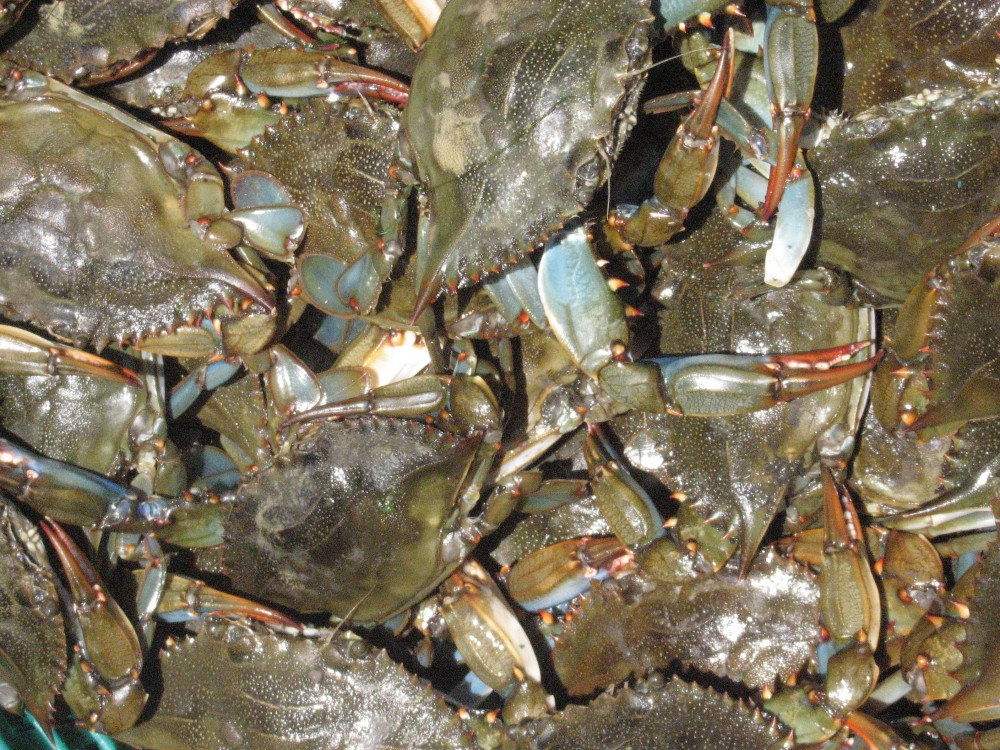
by Rick O'Connor | Sep 2, 2018
Most kids who grew up on the Gulf Coast grew up catching blue crabs. These animals are common along our shorelines, relatively easy to catch, and adventurous because they may bite you. I caught my first one in 1965 and we proudly displayed the boiled shell over the kitchen bar for many years. This is also a popular seafood target with an estimated commercial landing value of $56,950 in the Pensacola Bay area in 2017.
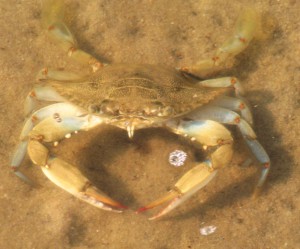
Blue crabs are one of the few crabs with swimming appendages.
Photo: Molly O’Connor
But who is this crab that we enjoy so much? What do we know about it?
As you probably already know, it is one of an estimated 30,000 species of arthropods we call crustaceans. Crustaceans differ from insects and arachnids in that they have five pairs of legs and two sets of antenna. Insects typically have a head, thorax, and abdomen – however, in the crustaceans the head and thorax are fused into what is called a cephlathorax and covered with a section of the shell called the carapace. Like all arthropods, their body are completely covered in a chitinous shell that serves as their exoskeleton. This exoskeleton must be periodically shed (molting) so they can continue to grow. Crustaceans tend to molt about 10-11 times each year and typically in the summer months. To molt, crustaceans will remove some of the salts and minerals from the shell into their tissue, this weakens the shell enough to separate it. The crack is usually between the cephlathorax and abdomen. When they emerge, they are completely soft and about 30% larger than before – it is amazing to see this large crab emerge from the small shell it once lived in. Because of the softness of the body after molting, this is usually done under the cover of darkness for protection. The salts and minerals it removed during pre-molting are now used to harden the new shell – which can take a couple of days. It is at this stage we call them “soft shells”.
The crustaceans include many different kinds of arthropods – most notably are the crabs, shrimps, and lobsters. There are over 4500 species of crabs and they differ from shrimps and lobsters in the fact their abdomen flexes beneath their body – you do not see the “tail” you see in a lobster or shrimp – but its there. Crabs can also move very well laterally, which their cousins are not so good. Blue crabs differ from other crabs in that their last pair of legs are modified as paddles and the animal can swim. They can swim forwards, backwards, and laterally – and they are often seen swimming at the surface. There are other crabs who have these swimming paddles and they are all called protunid crabs.
Blue crabs perceive their world through their eyes, antenna, and sensory cells on their body. They are very good at burying in the sand – eyes and antenna exposed – and sensory cells all working – seeking prey and avoiding predators. Their eyes differ from ours in that they have numerous lenses, compared to our single one, and are called compound eyes. Each lens does not provide them with an image of you or me however. Rather each lenses provides them with a single pixel of light. It is much like the image you see on television when they are trying to block out a brand name, or someone’s face. The more pixels (lenses) you have, the clearer the image. Those this type of eye does not give as clear an image as ours; it is very good at detecting motion and has served the arthropods very well over the years.
For blue crabs, food can be just about anything. They are active hunters – usually using the ambush method of capture (buried in the sand), but are also known scavengers – eating any bits of food they can find. Those enjoy crabbing know this – you can put just about anything as bait in a crab trap and it works. They have numerous predators including fish, birds, mammals, and sea turtles.
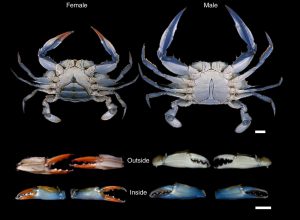
Male and female blue crabs.
Photo:
Blue crabs can be found in a variety of salinities (euryhaline). Males are typically found in the lower salinities of the upper bay. Females join them during mating season – which is in late spring and summer. Males cradle the females beneath his legs for several days waiting for the right location and moment to breed. Fishermen refer to them as “doublers” during this time. The females will molt and the male will then deposit his sperm into a sac called a spermatophore – which he then deposits to the female. She will then migrate to the more saline lower portions of the lower bay, while he remains and seeks another female. This may be the only spermatophore she receives her entire life – which can be up to five years, though most do not live beyond three years. She will use sperm from this spermatophore over that time to fertilize eggs.
The eggs develop in a sponge mass that develops beneath her abdomen. This egg mass is orange when in early development and becomes a darker brown with age as the larvae consume the yolk. There can be between 750,000 and 2,000,000 developing eggs within this mass. The females are called gravid at this stage and it is illegal to harvest gravid crabs in Florida.
The eggs hatch in about two weeks and a small microscopic mosquito looking larvae emerges – at this stage, they are called zoea. The zoea drift into the Gulf of Mexico where they feed and molt. Eventually they return to the estuary and become a microscopic crab with a tail – this stage is called a megalops. The megalops will feed and molt. The tail will eventually flex beneath and the crab becomes sexually mature. The entire process from hatching to sexual maturity is about 12-18 months.
These are fascinating animals. They are very common and a large part of the coastal culture of the Florida panhandle. Kids will have great fun catching them with a hand net, letting them swim in their beach buckets, but be sure to let them go before you head home and watch those claws – they do know how to use them. It is a great animal.
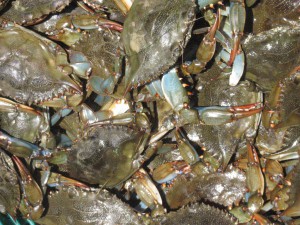
The famous blue crab.
Photo: FWC
Recreational Blue Crab Harvest Regulations in Florida
No size limit
10 gallons whole / harvester / day
Harvesting gravid females is prohibited
Five crab traps / person – cannot be placed in navigation channels
Trap closed season in Florida panhandle – Jan 5-14 in odd years.
References
Barnes, R.D. 1980. Invertebrate Zoology. Saunders College Press. Philadelphia PA. pp. 1089.
Blue Crab. Callinectes sapidus. Chesapeake Bay Program. 2018. https://www.chesapeakebay.net/discover/field-guide/entry/blue_crab.
Florida Fish and Wildlife Conservation Commission. Commercial Landings in Florida. 2017-2018. http://myfwc.com/research/saltwater/fishstats/commercial-fisheries/landings-in-florida/.
Florida Fish and Wildlife Conservation Commission. Recreational Blue Crabbing. http://myfwc.com/fishing/saltwater/recreational/blue-crab/.

by Laura Tiu | Aug 3, 2018
Written By: Laura Tiu, Holden Harris, and Alexander Fogg
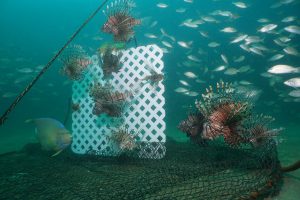
Non-containment lionfish traps being tested by the University of Florida offshore Destin, FL. Invasive lionfish are attracted to the lattice structure, then captured by netting when the trap is pulled from the sea floor. The trap may have the potential to control lionfish densities at depths not accessible by SCUBA divers. [ALEX FOGG/CONTRIBUTED PHOTO]
Red lionfish (Pterois volitas / P. miles) are a popular aquarium fish with striking red and white strips and graceful, butterfly-like fins. Native to the Indo-Pacific region, lionfish were introduced into the wild in the mid-1980s, likely from the release of pet lionfish into the coastal waters of SE Florida. In the early 2000s lionfish spread throughout the US eastern seaboard and into the Caribbean, before reaching the northern Gulf of Mexico in 2010. Today, lionfish densities in the northern Gulf are higher than anywhere else in their invaded range.
Invasive lionfish negatively affect native reef communities. They consume and compete with native reef fish, including economically important snappers and groupers. Their presence has shown to drive declines in native species and diversity. Lionfish possess 18 venomous spines that appear to deter native predators. The interaction of invasive lionfish with other reef stressors – including ocean acidification, overfishing, and pollution – is of concern to scientists.
Lionfish harvest by recreational and commercial divers is currently the best means of controlling their densities and minimizing their ecological impacts. Lionfish specific spearfishing tournaments have proven successful in removing large amounts in a relatively short amount of time. This year’s Lionfish Removal and Awareness Day removed almost 15,000 lionfish from the Northwest Florida waters in just two days. Lionfish is considered to be an excellent quality seafood, and they are now being targeted by a handful of commercial divers. Several Florida restaurants, seafood markets, and grocery stores chains are now regularly serving lionfish.
While diver removals can control localized lionfish densities, the problem is that lionfish also inhabit reefs much deeper than those that can be accessed by SCUBA divers. Surveys of deepwater reefs show lionfish have higher densities and larger body sizes than lionfish on shallower reefs. In the Gulf of Mexico, the highest densities of lionfish surveyed were between 150 – 300 feet. While SCUBA diving is typically limited to less than 130 feet, lionfish have been observed deeper than 1000 feet.
For the past several years, researchers have been working to develop a trap that may be able to harvest lionfish from deep water. Dr. Steve Gittings, Chief Scientist for the Office of National Marine Sanctuaries at the National Oceanic and Atmospheric Administration, has spearheaded the design for a “non-containment” lionfish trap. The design works to “bait” lionfish by offering a structure that attracts them. The trap remains open while deployed on the sea floor, allowing fish to move in and out of the trap footprint. When the trap is retrieved, a netting is pulled up around
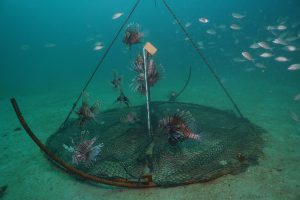
Deep water lionfish traps being tested by the University of Florida offshore Destin, FL. [ALEX FOGG/CONTRIBUTED PHOTO]
The researchers are headed offshore to retrieve, redeploy, and collect data on the lionfish traps. Twelve non-containment traps are currently being tested offshore NW Florida. The research is supported by a grant from the Florida Fish and Wildlife Conservation Commission. The study will try to answer important questions for a new method of catching lionfish: where and how can the traps be most effective? How long should they be deployed? And, is there any bycatch (accidental catch of other species)?
Recent trials have proved successful in attracting lionfish to the trap with minimal bycatch. Continued research will hone the trap design and assess how deployment and retrieval methods may increase their effectiveness. If successful in testing, lionfish traps may become permitted for use by commercial and recreational fisherman. The traps could become a key tool in our quest to control this invasive species and may even generate income while protecting the deepwater environment.
Outreach and extension support for the UF’s lionfish trap research is provided by Florida Sea Grant. For more information contact Dr. Laura Tiu, Okaloosa and Walton Counties Sea Grant Extension Agent, at lgtiu@ufl.edu / 850-689-5850 (Okaloosa) / 850-892-8172 (Walton).
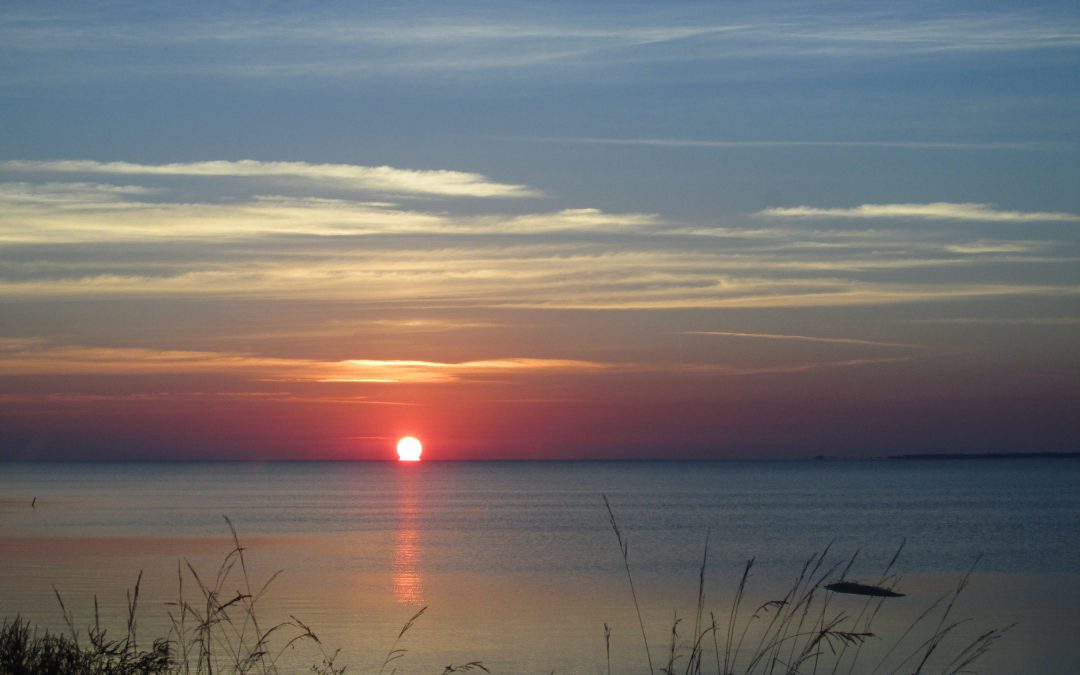
by Erik Lovestrand | Aug 3, 2018
If you have not seen the news yet, the US Supreme Court provided a ruling on June 27, 2018 regarding the decades-long conflict between Florida and Georgia over water use in the Apalachicola-Chattahoochee-Flint tri-state river basin. Guess what; the battle continues. Following the previous findings of the court-appointed Special Master and his recommendation to deny Florida relief in the dispute, there were many disappointed people south of the border between the two states. The recent decision to remand the case back to the Special Master for further consideration has taken many by surprise; happy surprise south of the border and not so happy as you look northward (unless you talk to the attorneys litigating the case, maybe).
The resulting decision kept Florida’s hopes alive for an equitable allocation of water resources in the basin that spans nearly 20,000 square miles of the Southeastern US. At stake, from Florida’s perspective, is the productivity and ecosystem integrity of the Apalachicola River and Bay ecosystem. For Georgia, enough water to supply its growing population and thirsty agricultural interests in the Flint River Basin south of Atlanta.
The Court’s 5–4 decision, found that the Special Master had applied too high a standard regarding “harm and redressability” for Florida’s claims. They ordered the case to be reheard so that appropriate considerations could be given to Florida’s arguments. “The amount of extra water that reaches the Apalachicola may significantly redress the economic and ecological harm that Florida has suffered,” said Justice Breyer, who was joined by Chief Justice John Roberts and Justices Anthony Kennedy, Ruth Bader Ginsburg and Sonya Sotomayor. “Further findings, however, are needed.”
The Court’s opinion does not actually outline any specific solutions for the water battle, and it in no way guarantees a win for Florida, but it does keep the legal challenge alive – along with the hope of better days for Florida’s oyster industry, which has suffered a major fisheries collapse that began around 2012. Visit this link if you would like to read the syllabus, as well as the full opinion of the High Court.
We should all consider the magnitude of the importance of the Apalachicola River and Bay for our region, due to its connection to the larger Gulf of Mexico. Estuaries like this are crucial links in the life-stages of countless marine organisms, including many we depend on for food and recreation. Blue crabs migrate tremendous distances to spawn in our near shore estuaries. Their young then disperse to populate large areas of coastline. Post-larval shrimp move into our estuaries to grow up after being spawned offshore. Later they swim out as adults to begin the cycle again. It is no wonder the shorelines of our Florida estuaries are dotted with prehistoric shell middens from peoples who thrived near these resource-rich ecosystems. Who knows if the Apalachicola Bay will ever recover to the productivity of its glory days, when a hard-working person could harvest 20 bags of oysters in a day? Regardless, we should all be thankful for what Apalachicola Bay has meant to so many generations of people over such a wide expanse of our Northern Gulf of Mexico coastline. Take just a moment to think about it, please.

by Erik Lovestrand | Aug 25, 2017
Many species of animals go through dramatic swings in population numbers over time. For some, these fluctuations are related to the dynamics of a natural symbiotic connection such as a predator-prey relationship. A classic example of this is the famous snowshoe hare/lynx model taught to all wildlife ecology students. The lynx numbers follow the hare numbers with a lag in the population upswings and downswings. For other species, it may simply be related to changing environmental conditions that they either do not tolerate well or that they thrive in. This is primarily the case with our panhandle bay scallop populations from year to year. During the time I’ve lived in North Florida I’ve experienced both ends of the spectrum during local scallop seasons. Some years, you can limit-out as fast as you can pluck them from the sea grass bed. Other times, the old adage of “finding a needle in a haystack” comes to mind. Over the past few years we have experienced some of these dramatic swings for various reasons.
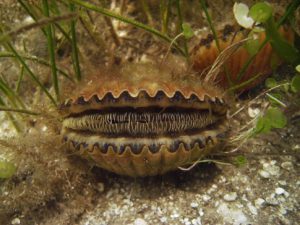
Bay Scallop Argopecten iradians
Bay scallops are mostly an annual species, with spawning taking place as water temperatures drop quickly during fall cold fronts. Harvest numbers the following summer are a result of larvae that matured in a single season. Occasionally, you will find an old “mossy-back” that is significantly larger and likely a holdover from the previous season. During spawning, a single scallop can release millions of eggs but very few survive to adulthood and throughout their brief lifespan they are susceptible to many mortality factors.
Predation by crabs, sea stars and several species of marine snails takes a toll but is generally not the driving force in significant declines.
One factor that does have population-level impacts is the amount of rainfall locally. Too much freshwater will create physiological stress and kill scallops over large areas. They can also be hammered by extreme heat or cold events due to their nature of inhabiting relatively shallow coastal waters. Other population pressures may not be so obvious because they sneak up on scallops gradually rather than happening all of a sudden. Factors such as propeller scarring in seagrass beds and siltation from terrestrial runoff or human activities, can have a cumulative effect that gradually degrades the seagrass habitat where scallops live. Another factor that can cause near-extinction of local populations is the occurrence of harmful algal blooms such as red tide. The toxins produced by these marine dinoflagellates will kill fish, marine mammals and shellfish alike. This is what happened to the scallops in St. Joseph Bay during the fall of 2015 when a red tide bloom killed most of the spawning population.
A more recent event in St. Joseph Bay, that put a damper on the 2017 season, was a bloom of a different marine dinoflagellate species known as Pseudo-nitzschia. This organism can produce a toxin known as domoic acid which can cause amnesic shellfish poisoning in humans. Thankfully, it is not expected to harm the shellfish themselves and next season may be a real bumper year. That is, if everything else that can go wrong for a scallop decides to give them a bit of a break. When environmental conditions are good, it is astounding what Mother Nature will provide. Put on your snorkel gear and check it out! For information on seasons and more detailed biology visit the Fish and Wildlife Research Institute’s webpage here. For some tasty recipes check out the Fresh From Florida page here.
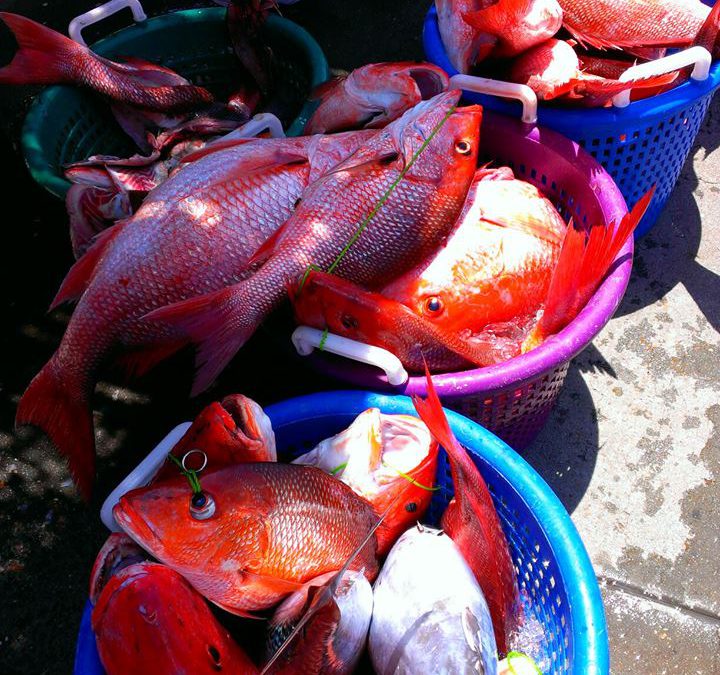
by Rick O'Connor | Aug 18, 2017
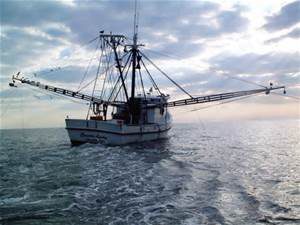
Shrimping in the Gulf of Mexico.
Photo: NOAA
Actually, if you like seafood – it’s all good! However, not everyone does and sometimes when this question is asked they are interested in not how it taste but where the seafood came from.
In recent years, there has been a move across the country to learn more about where their food comes from. Whether that is because they are concerned what the livestock and chickens have been fed, their living conditions, or whether they came outside the United States – more people are asking and it is affecting how they purchase their food. Is it the same for seafood?
In some cases, yes. Several years ago, I ran the marine science program at Washington High School. We were discussing whether, with a growing human population, the ocean could sustain the demand for seafood. Would we need to focus our production on aquaculture? We decided to survey locals to see whether (a) they liked seafood, and (b) if so, would it matter whether the product came from the ocean or a farm. Over a 10-year period, we found that (a) the percentage of locals who did not like seafood increased. (b) Those who did like seafood did not have strong feelings whether it was from a farm or from the sea. Curious as to why those who did not like seafood felt that way, we followed up with those questions and found it was not as much a concern with seafood safety in that they just did not like the taste of it. Of course, this was a high school science project and not a formal science investigation, but they did a good job with it and the results were interesting.
That was almost 20 years ago, do people feel the same? According to Dr. George Baker (Florida Sea Grant), yes… things are about the same. If they can get access to wild harvested seafood at a good price, they will buy. If it is not available, or to expensive, they will, purchase farm raised. Moreover, more people do not like seafood.
What about the local issue? In California, there is a program that allows you to find out which boat captain caught your fish. In Florida, there are studies going on to determine what type of filet you are actually buying. As with produce and livestock, people seem to be interested in where their seafood comes from – and for many, if effects where and how they buy seafood.
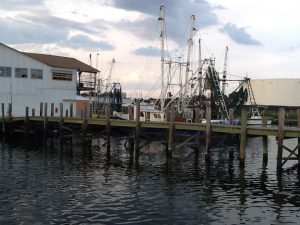
Commercial seafood in Pensacola has a long history.
Photo: Rick O’Connor
So what is local?
Well, we call any seafood product harvested or cultured within 250 miles local. For Pensacola, that would include Alabama, Mississippi, and eastern Louisiana. We know that between 80-90% of the seafood you currently purchase is imported from both commercial fishing and aquaculture overseas. That said, local seafood is still here and available.
The commercial fishing in Pensacola goes WAY back. It was one of the first industries to get off the ground shortly after Florida became a U.S. territory. According to Dr. Jack E. Davis, in his book The Gulf; The Making of an American Sea, Cuban fishermen harvested seafood from the Gulf coast of peninsula Florida prior to our becoming a territory. Shortly after becoming a U.S. territory, New England fishermen came to harvest the Gulf, including one by the name of Leonard Destin. Soon a fishing industry was operating in Pensacola. They sold a variety of species but in 1840 they found red snapper – and the boom was on. Shrimp followed but water quality, habitat loss, and overharvesting have plagued the industry over the years. Fishermen did well for a time, then the landings decreased, the fishermen believed the fish had moved, and so the fleet would move. This continued until they have literally moved all over the Gulf of Mexico seeking fish. At this point quotas had to be initiated and regulation has been the norm ever since. Add to this an increase interest in recreational fishing, increasing the number of fishermen, and increased regulation with this sector. Today we can include the introduction of invasive species as another stressor.
All that said, local seafood is still available. Some species have become quite pricey, but they are still available. The Gulf & South Atlantic Fisheries Foundation created a Gulf Coast Seafood Species Chart. This chart indicates when selected species are in peak season for commercial harvest. This chart suggests they are in season year round but there are peak months. It varies from one state to another, but the list below includes Florida and Alabama.
| Species |
Months in Peak Season |
Comments |
| Blue crab |
No peak season |
|
| Blue crab
Soft shell |
Mar – Jun |
|
| Black drum |
No peak season |
|
| Red drum |
No peak season |
Subject to quotas and closures |
| Clams |
All year – FL only |
Clams are now cultured in FL and are available year round |
| Crawfish |
Apr – Jun – LA only |
LA only, but close to us |
| Flounder |
Jul – Aug; Oct-Nov |
Subject to quotas and closures |
| Grouper |
No peak season |
Subject to quotas and closures |
| King mackerel |
Jan – Feb; Jul-Sep; Dec |
Subject to quotas and closures |
| Mahi-Mahi |
May – Jun |
|
| Mullet |
Jan; Sep – Dec |
|
| Oysters |
Jan – Apr; Sep – Dec |
|
| Pompano |
Jan – Apr; |
|
| Sheepshead |
No peak season |
|
| Brown shrimp |
May – Sep |
|
| Pink shrimp |
Jan – Jul |
|
| Rock shrimp |
Jun – Sep |
|
| White shrimp |
May – Nov |
|
| Snapper |
Peak season year round |
Subject to quotas and closures |
| Yellowtail snapper |
Mar – Jun |
|
| Spanish mackerel |
Jan – May; Aug – Sep; Dec |
Subject to quotas and closures |
| Spiny lobster |
Aug – Sep; Oct – Nov |
|
| Spotted seatrout |
No peak season |
Subject to quotas and closures |
| Stone crab |
Oct – Dec |
|
| Swordfish |
Sep – Nov |
|
| Yellowfin tuna |
Jun – Oct |
|
The health benefits from consuming seafood are understood. We certainly think it should be part of your of weekly dinner menu. There are concerns for safety in some seafood products, as in mercury and king mackerel, and we will address that in another article – but the lack of consuming seafood can create health issues as well. We hope you enjoy local Gulf seafood.
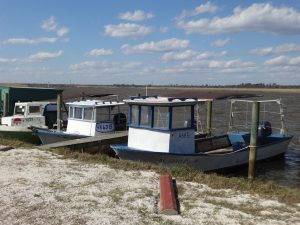
Commercial crab boats docked on Escambia Bay.
Photo: Rick O’Connor
References
Baker, G. 2017. personal communication.
Davis, J.E. 2017. The Gulf; Making of an American Sea. Liveright Publishing. New York NY. Pp. 530.
Gulf & South Atlantic Fisheries Foundation. 2013. Gulf Coast Seafood. www.eatgulfseafood.com

by Rick O'Connor | Jun 17, 2017
ARTICLE WRITTEN BY DR. CHARLES ADAMS, FLORIDA SEA GRANT
The demand for seafood in the US continues to grow. This growth is a function of a number of factors, including the increased awareness of the healthful attributes of many finfish and shellfish products, the increased availability of several key imported, cultured species (shrimp, tilapia, pangasius), and more convenient packaging for home consumption, to name just a few. In terms of wild-caught seafood, effective management at the state and federal level helps ensure the sustainable harvest of traditionally important species, such as reef fish, scallops, flounders, mackerels, and crab.

The famous blue crab.
Photo: FWC
According to the latest data from the National Marine Fisheries Service (NMFS), the US domestic fisheries fleet landed about 7.8 billion pounds of edible seafood products, valued at $5.2 billion. Florida plays an important role in this industry, particularly within the Gulf and South Atlantic region. Approximately $250 million worth of seafood is landed by the commercial harvesters in Florida on an annual basis, with some species being landed in Florida, and virtually nowhere else … including pink shrimp, spiny lobster, grouper and stone crab. But wild harvest is not the only source of finfish and shellfish products.
The commercial aquaculture industry is also growing, as the demand for species grown within controlled systems (such as catfish, oysters, striped bass, crawfish, and salmon) continues to increase. The latest NMFS data indicates that the commercial aquaculture industry in the US harvests approximately $1 billion worth of freshwater and saltwater species annually. The success story for aquacultured food items in Florida is molluscan shellfish, in particular cultured hard clams.
Though our wild seafood stocks are sustainably managed and aquaculture production is increasing, approximately 90% of the seafood consumed in the US is imported. Our domestic harvest and culture of seafood simply cannot keep up with demand. We are eating more and more seafood … with the latest NMFS estimate of annual, per capita seafood consumption being 15.5 lbs (edible meat weight). This is the highest level of per capita consumption since 2010. Even though demand is growing, consumers should be confident that the traditional species from our nation’s wild stocks will be there in the future. In addition, the aquaculture industry will help the seafood industry keep pace with growing demand. The seafood industry will continue to be an important source of incomes, jobs, and tax revenue for our coastal communities. And given the increasing number of cultured species and innovative packaging/preparation methods … now is a great time to be a seafood consumer!!
For more information about the US seafood industry, go to https://www.st.nmfs.noaa.gov/Assets/commercial/fus/fus15/documents/FUS2015%20Fact%20Sheet.pdf.















